Plant Galls
Description
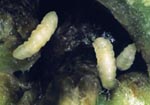
Figure 1. Larvae
Inside Wooly Fold
Gall on Red Oak
Abnormal warts, swellings, and knots on the leaves, twigs, and branches of trees and shrubs are usually galls. There are hundreds of kinds of galls--large and small, conspicuous and inconspicuous-- but each is characteristic of the organism that produced it.

Figure 2. Wooly Fold
Gall on Red Oak
Caused by a Fly
The gall-producer always remains faithful to a particular kind of plant. Most of the common galls are due to abnormal cell growth stimulated by insects and mites, but some galls are caused by bacteria, fungi, and nematodes. Still others are caused by aphids, mites, or fly larvae. On oak trees particularly, the growth of galls of many shapes is stimulated by a large number of species of small wasps belonging to the Cynipidae family.
Life History

Figure 3. Oak
Hedgehog Gall
The habits of the gall-maker are as varied as the galls. In general, the galls provide a home for the insect, where it can feed, lay eggs, and develop. In the case of the cynipid galls, the small wasps lay eggs on the developing buds and shoots. These hatch into legless grubs that cause the galls to develop. After development, the galls are deserted by the insects.
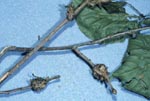
Figure 4. Linden Tree
Gall
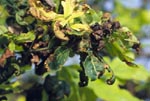
Figure 5. Potato Gall on
White Oak
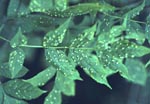
Figure 6. Phylloxera
Gall on Hickory
The numerous galls (green, reddish, or black) seen on the uppersides of maple leaves are stimulated by microscopic mites that overwinter under the bud scales of the trees. As soon as growth starts in the spring, the mites move to the leaves and stimulate gall growth. They feed, lay eggs, and live inside these galls.
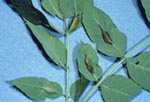
Figure 7. Ash Midrib Gall
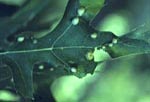
Figure 8. Small Oak
Apple Gall on Red Oak
Damage

Figure 9. Gouty Vein
Gall on Sugar Maple
The damage caused by galls is difficult to record or to estimate. The presence of galls does not indicate that the plant is diseased and is likely to die. The damage is localized; with a few exceptions, is not considered serious enough to justify spraying. Occasionally, however, galls develop in such numbers that the leaves become distorted and lose their natural beauty, or some may fall prematurely. Cynipid galls sometimes kill oak twigs and branches. The hickory gall aphid may seriously damage hickory twigs.

Figure 10. Phylloxera
Globosa Galls on Walnut

Figure 11. Gall on Bur
Oak Caused by a Wasp
Chemical Control
Usually control for galls is not needed or recommended.